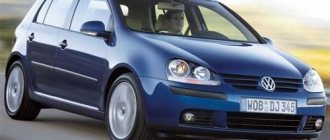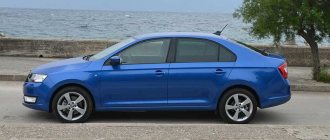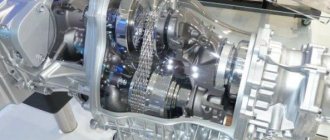While the fifth and sixth generation Golfs can be equated, as both used the same platform and similar technologies, the Golf 7 is a completely different story.
The VW Golf VII is similar to the sixth generation model, but there are many design differences.
The previous generation did not leave the best opinion of itself. In the seventh variation, Volkswagen Golf received a new MQB platform, well known from other models of the concern. New engines appeared under the hood. Instead of the old and rather problematic gasoline engines 1.2 and 1.4 TSI of the EA111 series, units of the EA211 family with a timing belt drive began to be used. Diesels of the EA189 series gave way to the more modern EA288.
The Seventh Golf was packed with electronic innovations. Already at the time of debut, it was possible to order active shock absorbers, a rear view camera, etc. Later, the list of options was supplemented by active cruise control, a blind spot monitoring system and an automatic braking system.
Weight loss
Additional concerns may be caused by the fact that Golf 7 has lost a lot of weight. For example, the body has become lighter by 37 kg, the chassis by 26 kg, and the electrics by 6 kg. The weight difference between the base Golf VI and Golf VII is 100 kg. Did this affect the quality? It seems to have had a little impact.
We heard, for example, about easily scratched front windows, as well as perishable rear door seals in five-door versions (water entered the cabin through them). Interestingly, in later cars (from 2021) the headlights may fog up.
In cars with an engine power of less than 120 hp. a torsion beam is installed at the rear, and in stronger versions there is a multi-link suspension.
Otherwise, nothing fatal. Workshops servicing corporate vehicles and drivers themselves respond positively to this model. So far, the Volkswagen Golf 7 does not create any serious problems. However, some malfunctions occurred. First of all, in popular versions the manual transmission bearings turned out to be not very durable. The box was either replaced under warranty or more or less successfully repaired.
As part of the service campaign, the front wheel axles were updated, which in the first batch of cars were made of poorly hardened steel. Some cars had problems with the brake booster. The brake pedal became stiff and the faulty brake system indicator came on. The culprit was the vacuum hose. It is quite difficult to change it.
Dimensions
Volkswagen Golf is a compact C-Class model. After the change of generation, it became longer, slightly narrower and taller. Its overall dimensions are: length 4284 mm, width 1789 mm, height 1456 mm, and wheelbase 2636 mm. The model is based on the latest version of the modular MQB platform. At the front, independent McPherson struts with anti-roll bar will be installed. At the rear, in simple equipment options, with weak power units, a semi-independent elastic torsion beam will be installed, and in higher trim levels, a non-standing independent multi-link system will be installed. By default, conventional shock absorbers and coil springs are installed all around. For an additional fee, you can order adaptive DCC struts with variable shock absorber stiffness.
Gasoline engines
At the beginning of production, the 1.2 TSI engine had problems with the timing regulator (until 2015). Official services replaced the phase regulator under warranty along with the control valve. It is worth checking whether the car you are interested in has had a replacement. VW fixed the defect free of charge until 2021.
A common problem that worries 1.2 and 1.4 TSI engines after 100-150 thousand km is an increase in oil consumption. The reason is coking and sticking of the rings. The cost of repairs is 100-150 thousand rubles. In 2014, modernized rings appeared. In rare cases, when the pistons are destroyed, it comes to scoring on the cylinder walls.
After 100-150 thousand km, the turbocharger actuator may require attention. Its rod jams or there is play. A new actuator is available for 16,000 rubles, and for a replacement in the service they will ask about 3,000 rubles.
All the engines mentioned above have problems with the water pump (7-18 thousand rubles), which does not withstand the interval of 210,000 km established by the manufacturer. It is better to replace it together with the timing belt after 100-120 thousand km. A timing belt kit will cost 7-14 thousand rubles, and the work of replacing the belt is estimated at 5-8 thousand rubles.
More powerful turbo engines 1.8 and 2.0 TSI (EA888 already 3rd generation) have proven themselves well. They no longer have a tendency to increase oil consumption, and the problem of carbon deposits on the intake valves has been solved with the help of an additional injector.
At the same time, there is a loss of coolant through the temperature control module. Thermostat is not an exact term, since the module also includes a water pump.
Before purchasing the GTI and R versions with the 2.0 TSI engine, you should check the service history and condition of the timing drive. Although the life of the chain has increased, the risk of premature stretching still exists.
The latest 1.0 and 1.5 TSI engines (also EA211 series) have not yet created problems. However, it should be remembered that the 1.5-liter turbo engine has a complex design, which may cause trouble in the future. In particular, the particulate filter and the ACT system, which turns off the cylinders when the engine is running at low loads. Some 1.4 TSI engines also have this system.
Engine
| engine's type | petrol | petrol |
| Engine location | anterior, transverse | anterior, transverse |
| Engine volume, cm³ | 1395 | 1197 |
| Boost type | turbocharging | turbocharging |
| Maximum power, hp/kW at rpm | 125 / 92 at 5000 – 6000 | 105 / 77 at 5000 |
| Maximum torque, N*m at rpm | 200 at 1400 – 4000 | 175 at 1500 – 4100 |
| Cylinder arrangement | in-line | in-line |
| Number of cylinders | 4 | 4 |
| Number of valves per cylinder | 4 | 2 |
| Engine power system | direct injection into the combustion chamber | direct injection into the combustion chamber |
| Compression ratio | 10 | 10 |
| Cylinder diameter and piston stroke, mm | 74.5 × 80 | 71 × 75.6 |
| Engine power | 125 | 105 |
Diesel engines
Diesel units from the new EA288 series also performed well. However, it does not happen without incidents. A typical problem with 1.6 and 2.0 liter turbodiesels is the low service life of the plastic coolant pump.
In addition, there are problems with the timing belt tensioner. After replacing the old Gates tensioner with a Dayco product, the problem no longer occurs. The belt should also be replaced along with it.
In a two-liter diesel engine, the engine mount on the gearbox side ends prematurely. The cost of a new part is 6-11 thousand rubles.
Mechanics also note cases of burnout of the gasket under the cylinder head of the diesel 2.0 TDI after 100,000 km. This is due to aggressive driving and too thin gasket. It is thinner compared to engines of previous series. The cost of repairs is high.
Among the typical malfunctions of diesel units, a clogged DPF particulate filter should be noted. Sometimes it can be cleaned. But even if you have to change it, the costs will not be as high as several years ago - about 27,000 rubles.
The last element that sometimes fails is Bosch electromagnetic injectors. The cost of one nozzle is about 27-30 thousand rubles. For repairing an injector at a specialized service center they will charge around 14,000 rubles.
Malfunctions
TSI engines are remembered for the stuck turbocharger valve, which freezes after the car has been idle for a long time.
There is also a relatively weak pump, which will have to be changed along with the timing belt. No more problems were noticed, since the mileage is still too short, and the problems of the previous generation were corrected by engineers. The 1.6-liter MPI is a standard of reliability; it used to have minor problems, which have now been resolved. There is information about the rest of the engines, but they were not sold in Russia, so it makes no sense to tell.
The gearboxes have been modified, the mechanics traditionally work on the edge, so they won’t last long. The DSG robot has lost its old sores, but it is still a cause of risk. It requires careful treatment and maintenance, otherwise you will have to change the mechatronics, clutch kit and dual-mass flywheel.
The suspension shows its worth, as before, its main elements last longer than 100 thousand kilometers. Maintenance is relatively cheap because the car is still new. The only condition is frequent alignment/camber so that the suspension remains quiet, although this feature does not allow you to hear the presence of any malfunctions.
Transmission
If your vehicle has a DSG dual-clutch transmission, the transmission fluid should be updated every 60,000 km. In the case of a 6-speed gearbox, the cost will be from 10 to 15 thousand rubles, depending on whether the original oil or a substitute is used. Only the original filter should be installed. The cost of updating the fluid in a 7-speed robot is less - about 8,000 rubles. Here, oil is poured into the mechanical part of the box and mechatronics separately.
A calm driving style will significantly extend the life of the mechatronics, clutch kit and dual-mass flywheel. Often the flywheel and clutch have to be updated after 100-150 thousand km. Mechatronics usually withstand more than 150-200 thousand km.
In case of repairs, the costs will be considerable. To resuscitate mechatronics you will need from 17,000 to 50,000 rubles, a clutch - about 40-60 thousand rubles, a dual-mass flywheel - 30-50 thousand rubles. To maintain smooth operation of the DSG, it is necessary to adapt the clutch in a timely manner.
The clutch of a manual transmission will cost 14-50 thousand rubles, and replacement work will cost over 15,000 rubles.
4Motion all-wheel drive modifications will require additional costs. The oil in the Haldex coupling needs to be updated every 60,000 km. It is worth replacing the filter along with it, although the manufacturer does not recommend this.
Variety of models and excellent performance
Rear view of a blue Volkswagen Golf 7, tuning field
The number of commercially available variants of the seventh generation Volkswagen reaches 11, while the power of the installed diesel (1.2 and 1.4 liters) or turbo-gasoline (1.6 and 2 liters) engines varies from 86 to one hundred and fifty horsepower. Depending on personal preferences and financial capabilities, the future owner can choose a modification with an automatic transmission with 6 or 7 speed modes, or a car with a five- or six-speed manual transmission.
As for the configuration, initially there were three of them - Comfortline, Highline and Trendline, while even the most affordable basic version has impressive technical characteristics and available options:
- ESP (including XDS);
- air conditioning system no.
- control of opening and closing of the central lock remotely;
- the presence of a handbrake button instead of the usual lever;
- multimedia system with 4 high-tech speakers and a five-inch display;
- Start-Stop system for stopping the engine.
The number of functions that car owners can install additionally is amazing. The list of proposed innovations includes not only an enlarged touch panel, the Discover Pro system, but also sensors that determine the driver’s health status, recognize road signs, etc.
If you decide to improve your Volkswagen Golf 7, make sure in advance that it will be affordable for you. In addition to the fact that the car itself will cost more than analogues from other brands, installing additional systems and options can increase costs by 30-50 percent. Updating multimedia equipment and control systems will cost the most.
Evaluating the performance of individual functional units, such as rear disc brakes (with ABS) and front brakes, rack and pinion steering and independent front and rear suspension with stabilizer, it becomes obvious how seriously Volkswagen took the development of the 7th generation of world-famous hatchbacks.
Chassis
Pronounced noise in the rear axle area is usually caused by faulty shock absorbers. Typical for pre-restyling cars. As a rule, shock absorbers were replaced under warranty. The cost of a shock-absorbing strut is 5-7 thousand rubles.
The silent blocks of the front levers last over 100-150 thousand km (200-900 rubles). The rear suspension silent blocks are even more durable.
Other problems and malfunctions
The rear view camera does not respond when reverse gear is engaged. The reason is that dirt gets through the door opening mechanism and damages the camera.
Humidity in the front and rear of the cabin. If water appears from the front, then an incorrectly laid drainage channel from the air conditioner evaporator is to blame. Water in the back is a problem with poorly installed seals.
If the coolant temperature and fuel level gauge suddenly fails, then you need to be prepared for an expensive replacement of the dashboard. Simply installing a device from another car will not work, since the complex electronic multiplex network has some kind of protection. However, this disease does not occur often.
In older vehicles, swelling of the paintwork is often detected at the junction of the rear wing and bumper. Traces of the beginning of corrosion are sometimes observed in places of chips above the windshield.
After 100-150 thousand km, the heater damper servo drive has to be repaired (3-5 thousand rubles).
From time to time, the servo drive of the gas tank flap lock also fails (2-3 thousand rubles).
Check well
Volkswagen Golf 7 deserves good ratings. Despite many new solutions and significant weight loss, there are practically no serious problems.
Potentially high costs can be associated with highly boosted diesel engines. It is worth remembering that diesel units take up more space in the engine compartment than smaller gasoline engines, and this increases the cost of maintenance and repairs.
You should also be aware of the potential costs when choosing DSG dual-clutch transmissions.
During the inspection, it is necessary to carefully check the operation of electronic systems, because malfunctions do occur. And repair costs are not always limited to software updates. Especially after careless elimination of the consequences of an accident.
Hatchback: ideal for traveling on any road
According to the manufacturer, the safety of the seventh generation Volkswagen Golf cars is at the highest level - the Euro NCAP test conducted in 2012 confirms this, giving the latest version of the hatchback a well-deserved 5 stars.
What is especially impressive is not so much the presence of 9 airbags and a rear collision avoidance system, but rather the ability of the car to close the sunroof and windows without direct command from the driver.
The ground clearance in the European version of the suspension for bad roads is 160 mm, which means that the ground clearance has increased by 20 mm compared to the previous modification. So you can drive such a car both on city roads and on snowy roads.
Volkswagen Golf test drive, videoSafety according to EuroNCAP
- Overall Safety Rating
- 94%
Adult safety
- 94%
Child safety
- 65%
Pedestrian safety
- 71%
Assistance systems
IIHS Safety
G Okay
A Acceptable
M Weak
P Poor
- Front test with small overlap area (25%) G
- Front test with partial overlap (40%) G
- Side crash test G
- Roof Strength Rating G
- Head restraint safety rating G
Evaluation of collision avoidance systems
Basic level, including additional equipment
Review results
Although there are no truly dramatic changes in the configuration and visual appearance of the latest generation Volkswagen Golf, significant improvements and an abundance of new features for a comfortable ride make the model very attractive to car owners.
The higher price than its class competitors, such as the Cirtroen C4 and Mazda 3, is offset by efficiency and technology, so many car enthusiasts prefer to initially pay more to drive a stylish and reliable car with low fuel consumption.
Technical characteristics and fuel consumption of Volkswagen Golf 7
| degree of pollution | fuel consumption per 100 km | model | |||
| 4 | 4.4 l. | track | 6.1 l. | city | 1.4 TSI DSG Highline |
| ⇓ | ||||||||||||||
| 1 | 2 | 3 | 4 | 5 | 6 | 7 | 8 | 9 | 10 | 11 | 12 | 13 | 14 | 15 |
| Minimal contamination | Maximum pollution |
Published: December 22, 2014
Modifications
Volkswagen Golf Sportsvan
In 2014, the Golf Sportsvan was introduced. This is a large compact van built on an extended MQB platform.
Volkswagen GTE and e-Golf
The plug-in hybrid version of the GTE provides good performance. The total system power is 204 hp, and according to the manufacturer, the car can travel 50 km on electricity. However, auto journalists managed to drive no more than 23 kilometers in winter tests.
The all-electric version of the e-Golf, according to VW, is capable of covering 190 km (115 hp version), and later 300 km (136 hp).
Volkswagen Golf GTI and GTD
The family of sports Golfs opens with the GTI variant. It was only available as a hatchback, and its engine developed a power of 220 - 310 hp. The GTI, of course, has tartan seats, front-wheel drive and an electronically controlled differential lock. For the budget conscious, there is a GTD option with a 2-liter diesel engine producing 184 hp. It's similar to the GTI, but has slightly lowered and stiffened suspension.
The most powerful is the flagship version Clubsport S, released in a limited edition of 400 units.
Volkswagen Golf R
At the top of the sporty list is the powerful R version, which always comes with all-wheel drive. Similar to the GTI, you can choose between a manual or DSG automatic transmission. For the first time, the Golf R was also available as a station wagon. From 2013 to 2021, the engine output reached 300 hp, and after that – 310 hp. With DSG, acceleration to 100 km/h took 4.6 seconds.
In 2016-2017, the manufacturer offered a limited version of the R360S, whose EA888 engine developed 360 hp.
Add a review
Engines, suspension and transmission
]Volkswagen[/anchor] has equipped the eighth-generation Golf with a whole range of power units (13 possible options in total), including gasoline and diesel internal combustion engines with a volume of 1.0 to 2.0 liters, hybrid installations, and only pure battery versions are missing.
All internal combustion engines are turbocharged, with three or four cylinders, and there is also an option for an engine running on liquefied natural gas.
Europeans have access to Golfs with two types of 2.0 TDI diesel engines – 115 and 150 hp. s., and the base gasoline unit is a 1.0-liter 3-cylinder internal combustion engine with 89 horsepower (there is also a liter 110-horsepower engine).
One and a half liter engines are offered in 130- and 150-horsepower versions, “mild hybrids” eTSI – with a power of 110, 131 and 150, and eHybrid with plug-in drive – 204 and 245 hp. With.
The transmission is presented much more modestly - it is either a six-speed manual BVM6 gearbox or a DSG-7 robotic gearbox.
The Golf-8 hatchback, which is promised to be delivered to Russia no earlier than the fall of 2021, will most likely be supplied in only two versions - with a naturally-aspirated 1.6-liter engine producing 110 hp. With. and a 1.4-liter TSI engine with 150 horsepower. Estimated price from $22,000.
In all modifications, the German hatchback receives only front-wheel drive, McPherson suspension at the front, but the rear axle can be a torsion beam (in the budget version) or a multi-link type (in top versions).
The optionally available adaptive suspension control allows you to fine-tune the chassis to the road surface conditions, with driving modes “Economical”, “Comfortable” and “Sporty”.











